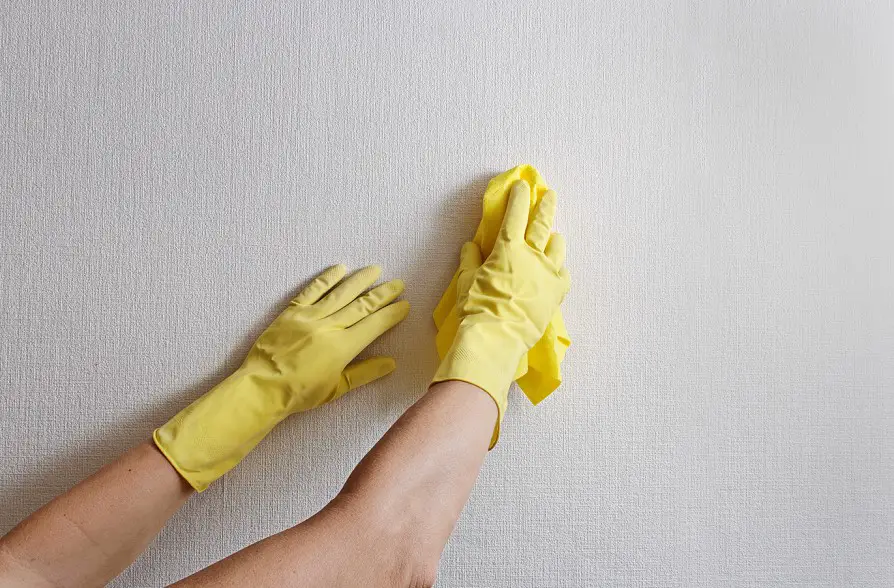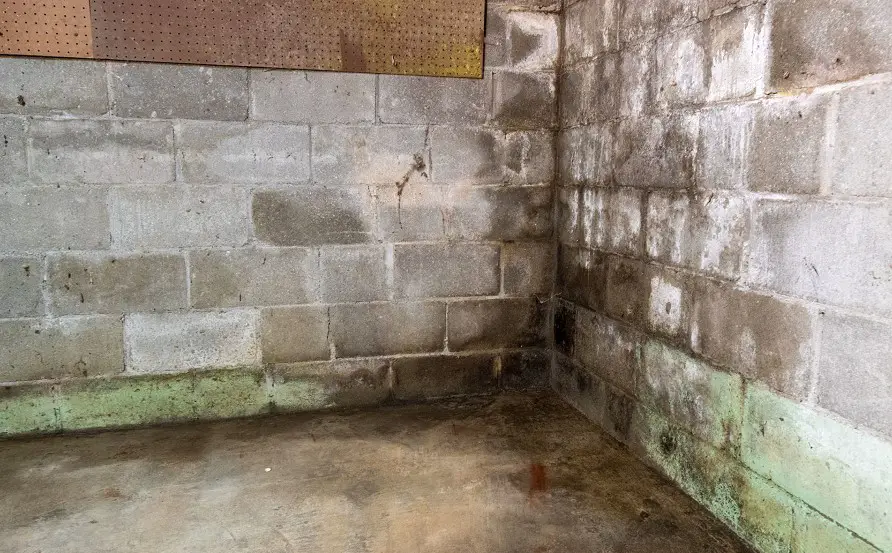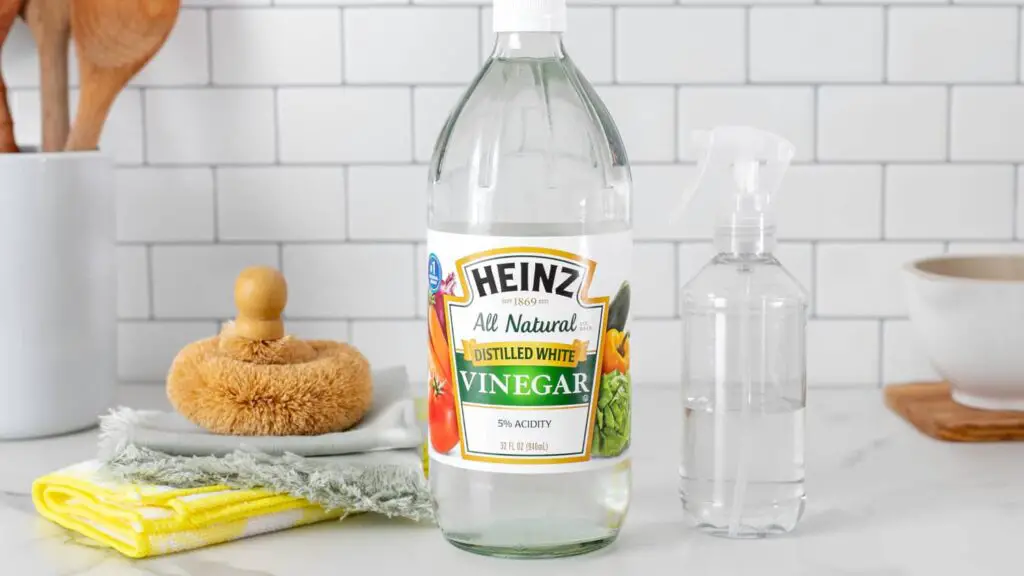There is a basement in almost all houses. And it is important to remember the need for regular cleaning of the walls to maintain the right microclimate. More about how to clean basement concrete walls will be discussed in this article,

Contents
- 1 The most common basement wall stains
- 2 The need to clean concrete basement walls: methods
- 2.1 Application of trisodium phosphate for the concrete wall
- 2.2 Bleach solution for the concrete wall
- 2.3 Application of ammonia for the concrete wall
- 2.4 The use of hydrochloric acid for the concrete wall
- 2.5 The use of hydrogen peroxide for the concrete wall
- 2.6 Application of borax solution for the concrete wall
- 2.7 Application of vinegar for the concrete wall
- 2.8 The use of hydrochloric acid for rust
- 2.9 Applying a mixture of vinegar and lemon juice
- 2.10 Using tea tree oil
- 2.11 High-pressure washer application
- 3 FAQ
- 4 Conclusion: concrete stains on the basement walls – what to do?
The most common basement wall stains
Before proceeding to study the question of how to clean basement walls, you should familiarize yourself with the most common types of stains that can form. Stains don’t just spoil the attractiveness of the walls.
They can contain fungi and mold, which negatively affects the health of all households.
Not all stains are due to mold.
In most cases, spots appear because groundwater is trying to get out.
Even a good foundation cannot prevent wall stains, especially if the ground around the concrete basement wall is wet.
Determination of the stain is an important step in the work in the basement. Based on the origin of the stain, you can choose the right cleaning products. More about the main types of common basement wall-stains will be discussed below.
The efflorescence
This substance has a snow-white hue and is presented in the form of a powder. It can coat walls in a basement when groundwater seeps into the concrete and begins to deposit mineral salts.
The only disadvantage of efflorescence is that they spoil the attractiveness of the concrete structure.
There is no reason to panic because efflorescence does not harm human health. However, they may indicate that the concrete is too wet.
Therefore, you need to start solving the problem immediately. If you do not control everything, then additional serious problems may arise due to high humidity.
It is possible that due to high humidity, you may notice mold growth.
To remove efflorescence, you can use the Eco-Etch Pro cleaner, which is designed to work on concrete. The product does not contain toxins and volatile organic compounds.

Spots of red and orange. Gray or black spots
If you start noticing red or orange spots on the interior concrete walls in the basement, then rust is developing. This happens if concrete walls are impregnated with iron ocher. This happens if you live in a region where the soil contains a high concentration of iron.
The ochre is carried by groundwater and begins to accumulate in basement walls. Even though iron ocher is not harmful to health, it can cause clogging of sewer and water pipes because it accumulates in them. It is extremely important to get rid of ochre properly.
After all, it can paint all other surfaces, including plastic structures and carpets. Cleaning is recommended by Singerman Laboratories. This agent has been specially developed to combat rust on concrete surfaces. It does not contain toxins and is safe for the respiratory system.
Rust can still appear if the reinforcement is exposed on the interior concrete walls. It is often used to additionally strengthen walls. As long as the reinforcement is inside the wall, it does not rust because it does not come into contact with air.
If the metal is exposed, then rust begins to form.
If you notice gray or black spots on the concrete basement walls, chances are that these are signs of mold. Its development is associated with a humid environment and high temperatures. It may also indicate that there are organic substances inside the concrete walls, which are a source of mold nutrition.
To avoid the formation of mold, it makes sense to control the factors that cause it to appear. The humidity in the basement must be less than 60%.
Flaking and destruction of materials
Quite often, people try to treat the concrete walls in the basement with materials that prevent air and moisture penetration. It can be a variety of sealants, paints, and hydraulic cement. As water seeps into the walls, pressure increases under the finish.
Because of this, the coatings collapse, which confuses the basement. Do not work in the basement with sealant and paint because this causes a mess. It takes causes more time and money to fix the problem. You have to clean and sand the walls if there are chips.
If you plan to use a sealant, then choose products that are designed to work with concrete. Products must be moisture-resistant to block the passage of water. Often, delaminations can form if the concrete walls were not properly prepared before applying the sealant. They must be clean and dry.
Cracks in the walls
When concrete begins to crumble, detachments form. If you are faced with cracking, you have to immediately begin to solve the problem. If this is not done in time, then a complete replacement of the concrete basement wall may be required.
Detachments can form if water penetrates the wall. It is deposited between the concrete particles if it contains salt. As it expands, it enlarges the spaces, making the concrete brittle. To avoid the issue, it is recommended to maintain an optimal level of humidity.

The need to clean concrete basement walls: methods
You must take your time when cleaning concrete walls. First, you need to remove the cobwebs, debris, and various pollution. You need to start work from one corner, moving in different directions.
After that, you can proceed to the main stage of cleaning using certain materials.
Application of trisodium phosphate for the concrete wall
It dissolves well in water and contains a high concentration of alkali. If you plan to use it to clean concrete walls, prepare 1 gallon of water, 3 ounces of trisodium phosphate, a container, and a wire brush.
Once the tools are ready, proceed to clean, adhering to several steps:
- Apply water to the concrete basement wall and scrub it thoroughly with a metal scrub brush. This makes the dirt more malleable.
- Use a water hose for better cleaning.
- Mix trisodium phosphate and water.
- Spray the product on the surface of the wall, and rub the concrete wall-stains well.
- Rinse off with fresh water.
- Open the windows and doors in the basement to speed up the drying of the concrete walls due to good ventilation.
If you decide to use this tool, it makes sense to choose the right drugs in which it is included. The best solution is Tri-Sodium Phosphate from Sunnyside.
Bleach solution for the concrete wall
This tool is a perfect solution if you need to remove mold growth and moss basement wall stains. Bleach solution has disinfectant properties and helps preserve the texture of concrete.
For work, you should prepare an equal amount of water and bleach, a spray bottle, a container, and a sponge.
Dilute the bleach in water and apply it to the concrete walls using a spray bottle. After carefully wiping the surface with a sponge.
Finally, rinse well with fresh water. It is recommended to work with rubber gloves. Remember to wear a protective respirator and goggles to protect your mucous membranes from bleach and harmful fumes.
Do not add ammonia or vinegar to the solution to increase effectiveness. Otherwise, the release of harmful and dangerous toxins begins. You need to work in a room with good ventilation, so as not to inhale fumes.
Application of ammonia for the concrete wall
Ammonia-based product copes well with stains on concrete walls in the basement. This component contributes to the destruction of fat and dirt.
It is also a suitable solution if you need to remove stubborn stains. To work, you have to prepare dishwashing detergent, warm water, a quarter cup of ammonia, and a nylon scrub brush.
Dilute water and prepared ammonia in a bucket. Then add some dish soap. Using a nylon brush, apply the product to the walls and rub the stains liberally.
It is important to cover the entire surface of the wall. Then rinse with clean water and pat dry with a clean towel.
The use of hydrochloric acid for the concrete wall
A hydrochloric acid is an effective tool for work. It makes sense to choose it if you need to deal with persistent stains.
To prepare an effective solution, prepare 4 gallons of water, 1 gallon of hydrochloric acid, a large container, and a stiff brush.
Once the tools are ready, get to work:
- Wipe the surface of the concrete basement wall with a mop, then dry.
- Prepare a solution based on hydrochloric acid and water. Apply the solution to the walls.
- Rub the stains well with a scrub brush, then wipe the concrete basement wall with a mop several times. This removes the remaining things.
- If you use hydrochloric acid, be aware of its toxicity. The basement must be well-ventilated. You need to work with gloves, a respirator, and goggles.
The use of hydrogen peroxide for the concrete wall
Many people use hydrogen peroxide to clean concrete basement walls. It helps fight bacteria and viruses.
Therefore, the surface of the basement wall is disinfected, which is an excellent solution if there are signs of mold growth on the walls.
For work, you should prepare a hard bristle brush, a spray bottle, and a 3% hydrogen peroxide solution. To get rid of mold stains on the walls, follow these steps:
- Pour the hydrogen peroxide solution into a spray bottle and apply it to the walls.
- Leave for half an hour for the product to work.
- Use a brush to scrub the stains well to remove mold particles if there are any in the porous concrete walls.
- Use the hose to start flushing out the remaining solution. You need to work with warm water so that the walls are shiny, and you can remove mold spores that have stuck.
- Dry the surface of the walls afterward using a clean towel. This helps to clean up water stains. And you can prevent mold re-infestation.
Application of borax solution for the concrete wall
Quite often, greasy and persistent stains appear on concrete surfaces in the basement. To get rid of them, you should use a solution of borax.
This is a fairly effective tool that helps to quickly get rid of stains.
To work, you need to prepare half a glass of borax, 1 gallon of water, half a glass of washing soda, 2 ml of dishwashing detergent, a brush, and a bucket.
Once the tools are ready, proceed to the main stage of work:
- Mix dish soap, borax, and water in a bucket.
- Use a brush to blend everything. It is better to mix the composition for several minutes.
- Then pour the solution into a spray bottle. If you notice the formation of sediment, you should shake everything well for effective mixing.
- Apply the product on surfaces that are stained with grease or mold. Leave it for a few minutes.
- It is not necessary to rinse off the product because it blocks the re-development of mold.
Application of vinegar for the concrete wall
If you’re looking for a safe way to clean concrete basement walls, you can use vinegar. The tool is very affordable and is in almost all homes.
Vinegar is practically odorless; however, it effectively disinfects surfaces. To work, you need baking soda, vinegar, and water.
First, apply vinegar to areas where signs of mold are visible. Leave it for 1 hour so that the acid begins to penetrate the pores of the basement wall and destroy the mold spores.
Then prepare a solution of water and soda, and apply it to the walls with a spray bottle.
This improves work efficiency. At the end of the work, the walls should be washed with clean fresh water.
You can use the same method if you need to clean pipes in the basement. This helps to cope with the unpleasant odor from sewage.

The use of hydrochloric acid for rust
If you notice traces of rust on the walls in the basement, you can get rid of them with hydrochloric acid.
This tool is very effective and copes with most stains. To prepare an effective cleaning solution, mix 2 cups of hydrochloric acid and 1 cup of pure water.
Apply the product to the basement wall using a spray bottle. Pay special attention to areas where there is rust.
Leave the solution on for 1 minute, then start scrubbing the stains with a stiff brush. Finally, rinse the surface with clean water. Repeat if necessary.
Do not leave hydrochloric acid on a concrete surface for a long time. Otherwise, the walls may turn blue. Remember to wear protective equipment while working.
Read the instructions on the label carefully. After all, hydrochloric acid is not compatible with certain substances.
Applying a mixture of vinegar and lemon juice
As mentioned earlier, vinegar helps to effectively deal with dirt on the walls. However, to improve its properties, you can add a little lemon juice to the solution.
This increases the acid levels, so you can dissolve the rust on the walls as well as kill the bacteria.
For work, in addition to the main substances, a sprayer and a stiff brush are required.
A sprayer makes it easier to apply the product, and a stiff brush help remove stains quickly. Once the elements are ready, you can start the main work:
- Apply vinegar and lemon juice solution to the stained area. Then leave for 10 minutes to absorb it.
- Scrub the basement wall stain using a stiff brush. If the stain is stubborn, apply some pressure on the brush to work more effectively.
- Rinse the surface using cold water. If the stains are difficult to get to, you can use a spray bottle. If necessary, a repeat procedure is required.
Using tea tree oil
It should be noted that tea tree oil is considered a natural fungicide. It helps fight mold and mildew stains. You can work with this tool on different surfaces. It can be not only concrete in the basement but also clothing.
You need 1 cup of pure water, as well as 20 ml of tea tree oil. For ease of use, prepare a sprayer, as well as a stiff brush.
To begin, apply the product on the wall, and leave for 10-15 minutes until absorbed.
After 2 days, you should repeat the work.
After that, clean the stains using a cloth or a stiff brush. This help to quickly deal with pollution.
Be aware that tea tree oil is considered a harmful toxin for pets. Make sure your pet does not swallow it. Try to keep pets out of the basement until the entire cleaning process is complete.
High-pressure washer application
Frequently, the walls in the basement are washed using a pressure washer.
This help to quickly and effectively deal with various contaminants. If you want to avoid cleaning your basement walls to get wet, it is best to cover them with a film or cloth.
When you add detergent, try to follow the instructions that are prescribed by the manufacturer.
If you would like to work with high-pressure washers, it is better to work alternately with different sections.
It is recommended to apply detergent with wide movements.
Leave it for a few minutes so that the product penetrates the concrete surface and destroys all contaminants. If the stains are too stubborn, scrub them further with a stiff brush.
After that, rinse the high-pressure washer by filling it with clean water. This help removes detergent residue.
After, you need to rinse the basement wall with clean water to remove the remnants of dirt and detergent. To do this, set the maximum power for work.
When all soap residue is removed, it makes sense to wipe the surface dry. To do this, you can use a towel or rag.
For ease and speed of work, use a dry mop. After that, leave the basement for a day with doors and windows open to completely dry all areas.

FAQ
When it comes to cleaning concrete basement walls, many questions can be asked.
How do you remove black mold from concrete basement walls?
The easiest way to remove black mold from concrete walls in the basement is with hydrogen peroxide. The drug must be mixed with clean water.
After the solution is applied to the areas affected by mold. It is better to leave the remedy for 10-15 minutes so that it works better. After that, you can remove the remaining mold using a hard brush.
How do you clean painted cinder block basement walls?
You can mix some clean warm water with dish soap. Then soak a stiff brush in the prepared cleaning solution. Start wiping the walls effectively.
Periodically wet the brush in the cleaning solution, moving in different directions.
How do you clean a concrete basement?
If the concrete surfaces in the basement are too dirty, you can mix dish soap, warm water, and a little ammonia.
For 1 bucket of water, add a quarter cup of ammonia. Apply the product with a stiff brush made of nylon.
Working with metal brushes is not recommended. After all, the fibers can get stuck in the wall, and then become rusty.
Conclusion: concrete stains on the basement walls – what to do?
As you can see, concrete basement walls can be cleaned using different methods. Both homemade and purchased products are appropriate. The main thing is to effectively remove contaminants. If even a slight stain remains, it may increase over time.
Also Read About Finishing Touches For Your Unfinished Basement


